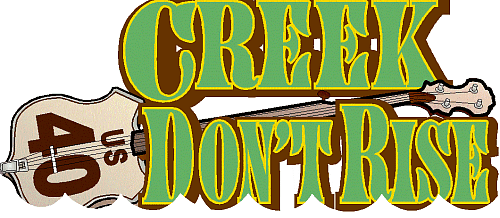



|
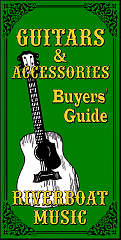

| Written by Paul Race for Creek Don't Rise? |
Editor's Note - I wrote much of the following content after my first experience shopping for and buying a banjo pickup several years ago. Since then, I've experimented with several other technologies, and decided that some of the more expensive technologies were more effective, especially for pro use. But piezo-electric add-on pickups for banjos still have their place. I have added additional notes and observations to this article.
Piezo-Electric Banjo Pickups
Piezoelectric pickups are based on century-old technology - the same technology that worked on cheap mid-century phonographs. Piezoelectric chrystals produce minute amounts of elecrical energy when they are stressed. They started being used for acoustic instrument amplification in the 1960s. Today, a wide range of piezo pickups are available for musical instruments, and they are standard equipment on "acoustic-electric" guitars.
Generally, built-in piezo pickups are embedded in the instrument bridges. Aftermarket piezo pickups built right into bridges are available, but the most common versions are attached directly to the instrument face (or banjo head).
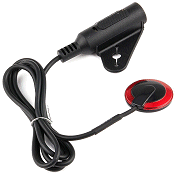 The little photo to the right shows an inexpensive piezoelectric pickup that consists of two main pieces - a piezoelectric crystal in a little housing you can glue on the underside of your banjo head (or inside a guitar or mandolin's face or wherever) and a jack that you can screw under a bracket of your banjo (or under the end pin of your guitar or whatever). More elaborate solutions include electronics to improve the sound and output and more solid ways of attaching the jack.
The little photo to the right shows an inexpensive piezoelectric pickup that consists of two main pieces - a piezoelectric crystal in a little housing you can glue on the underside of your banjo head (or inside a guitar or mandolin's face or wherever) and a jack that you can screw under a bracket of your banjo (or under the end pin of your guitar or whatever). More elaborate solutions include electronics to improve the sound and output and more solid ways of attaching the jack.
Technically, there's little difference between the $15 versions and the $100 versions, except for quality control.
Frequency Characteristics - Piezos pick up higher frequences better than magnetic pickups, though not as well as microphones. However, they pick up frequencies unevenly, so some notes may seem to be "clanging," and the overall tone may seem to be "quacky" (like a duck). And these artifacts vary from one pickup to the next. The better brands sound better largely because they throw away the units that don't meet their specification.
In addition, piezos fall off a bit in the low end, which may or many not be a problem for you depending on how you're using your banjo. If you're playing Dixieland-style way up the neck, you'll never notice, for example.
All of these issues can be somewhat rectified by a good equalizer and/or preamp (below). If you're running into a guitar amp that has good frequency range and a midrange control, you may be able to tune out major frequency issues.
Volume Characteristics - Compared to other technologies, the output of piezoelectric pickups is a bit low. If you have a lot of headroom on your amp, it's not a problem. To solve both frequency irregularities and low output, several professional applications include a preamp with a built in equalizer. Some preamps built specifically for piezoelectric pickups include circuitry to "even out" any frequency range issues, so they make the things sound better even without knobs you can twirl.
Lack of Built-In Solutions - Today most acoustic-electric guitars have battery-powered preamps built right into the guitar, with circuitry that compensates for the uneven output of the piezo. Unfortunately, nobody makes a banjo that way, yet.
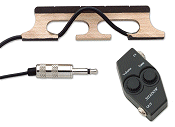 Bridge Pickup - Shadow and a few other companies make a piezo-equipped banjo bridge
Bridge Pickup - Shadow and a few other companies make a piezo-equipped banjo bridge. These sort of pickups are very popular among people who play violins and related instruments because they seem relatively unobtrusive and don't require any permanent changes to the instrument. However, on banjos, they pick up less of the head vibrations, so you may or may not find them as effective as the more common kind that sticks on the underside of the head.
Installing a "stick-on" Piezo Pickup - A pickup stuck on the underside of the head is almost invisible and it picks up the head vibrations, presumably the most distinctive part of any banjo's sound.
My first banjo pickup ever was a one-piece banjo AXL pickup that cost about $17, which I installed in a "pop-top" (aluminum-shell) banjo that I needed amplifed in a hurry cheap.
The photos below show the inexpensive pickup installed. I ran the output to a $200 guitar amp with no problems, though if I was using it in a more demanding application, I may have used a preamp and/or an "acoustic" amp (which are designed to handle higher frequencies).
 I would do this to a "beach banjo" again without thinking twice. However for a more expensive banjo, I'd use the Schatten bracket-mount jack assembly shown above, instead of drilling a hole.
I would do this to a "beach banjo" again without thinking twice. However for a more expensive banjo, I'd use the Schatten bracket-mount jack assembly shown above, instead of drilling a hole.
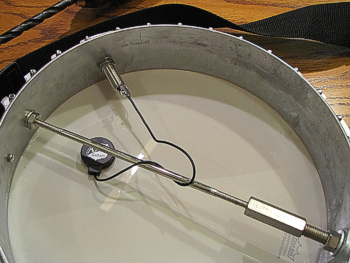 |  |
 As I write this, other solutions are becoming available, including the "inline jack" solution that was technically invented for guitar amplification. This hasa cylindrical preamp that sits on the back of the endpin jack. Wires run out of it to a battery cap, and there's a little 1/8" jack that accepts input from a piezo pickup. Some have wires running out to little volume and tone control dials that you're supposed to put on the inside of your guitar so that they stick out just far enough for you to turn. But there's no good place to mount those on a banjo so I'm looking at the ones sans controls. (I expect any amplifier or mixer I use to have those, after all.)
As I write this, other solutions are becoming available, including the "inline jack" solution that was technically invented for guitar amplification. This hasa cylindrical preamp that sits on the back of the endpin jack. Wires run out of it to a battery cap, and there's a little 1/8" jack that accepts input from a piezo pickup. Some have wires running out to little volume and tone control dials that you're supposed to put on the inside of your guitar so that they stick out just far enough for you to turn. But there's no good place to mount those on a banjo so I'm looking at the ones sans controls. (I expect any amplifier or mixer I use to have those, after all.)
 Most of these come with a stickum-and-velcro solution for mounting the battery inside you guitar. That's one place where owning banjos is easier - so if I install something like this, I'll just screw a little metal battery clip inside the banjo shell - I don't mind two little holes where no one will ever see them.
Most of these come with a stickum-and-velcro solution for mounting the battery inside you guitar. That's one place where owning banjos is easier - so if I install something like this, I'll just screw a little metal battery clip inside the banjo shell - I don't mind two little holes where no one will ever see them.
Unfortunately, the piezo pickups that come with them are long skinny things you're supposed to stick under the "saddle" of a guitar bridge. So you'll probably want to buy a stick-on pickup to wire into it.
Now there is no compelling reason that Schatten or someone couldn't put the whole thing together in a single, reasonably-priced package. Perhaps by the time you reade this, someone will have.
Commercial Piezo Pickup Choices
Once you get under, say $80, the products are all pretty much identical, including the $15 ones. Generally, there's a round pickup about the size of a nickel that sticks on the inside of the banjo head with a goey adhesive or the equivalent of double-faced tape. Shielded but tiny wires attach the pickup to a jack that attaches somewhere on the banjo. One versionThis section largely describes the choices I examined before I put my first piezo on a banjo. Again, there are many other variations available, and all make great promises, and some fulfill some of their promises. But this is a representative sampling.
You can get to the inside of most banjos very easily by taking off the resonator (if there is one), which makes these things much easier to attach to a banjo, say, than an F-hole mandolin.
 On some versions (including the one with the volume control
On some versions (including the one with the volume control), the jack is attached to a clamp that clamps onto two of the head-tightening brackets. This should be pretty reliable and it shouldn't cause much permanent damage to the body of banjo in case you want to restore it to its original condition. In fact I looked for a pickup like this that had a preamp as well as a volume control, that would clamp to the brackets on my banjo. Several off-brand manufacturers advertised products along those lines, but most of them required you to buy two or three separate items and glom them together somehow. They also had no documentation or specs to speak of, and you couldn't even tell for sure which preamp went with which pickup, etc.
I chose to pass, rather than buy some combination of things that would definitely
 look weird on my banjo and might not work at all.
look weird on my banjo and might not work at all.
On some versions
, the jack is attached to a velcro strip that's supposed to wrap around one of the brackets. Like the version above, it keeps you from making permanent changes to the body of your banjo, but folks have complained that it's not all that solid. If someone, say, steps on the cord, the resulting tug could pull the jack off your banjo and break the little wires connecting the jack to your pickup.
If I was using one of these, I might be tempted to have the guitar cord wrap around a bracket once before going into
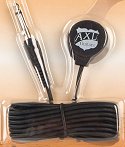 the jack, as a sort of stress relief.
the jack, as a sort of stress relief.
- On some versions
, the pickup is attached directly to a long cord with a guitar plug at the other end. You would definitely want to wrap the wire going to the plug around something as stress relief. But I can't imagine the hassle of having a long wire running out of my instrument all of the time.
On the other hand, this would be a great solution for drummers wishing to attach sensors to drum pads or the like.
This might also be a good-enough solution for someone using a belt pack wireless transmitter.
- On some versions
the jack is
 supposed to clamp onto the strap or onto the end-pin connector.
supposed to clamp onto the strap or onto the end-pin connector.
I don't see anything intrinsically wrong with this except that it seems somehow "sloppy" to me to have wires running out of the banjo to a whodinky on the strap.
- On some versions
, the jack is meant to replace the end-pin on a guitar, mandolin, or other wooden instrument where the strap attaches to the pin. This is the one I wound up deciding on, because I wanted something that was basically bullet-proof once I installed it, and I didn't really mind drilling a hole.
 I've put similar Barcus Berry products in acoustic guitars before, so I wasn't afraid of it, but the banjo doesn't actually need an end pin. When I pulled the thing out of the packaging, I realized that if you leave the end pin screw-on adapter off, the jack looks just like any other guitar jack. For a while I toyed with the idea of dummying up some way to fasten the jack on the flanges or to the brackets, so I wouldn't have to drill a hole in the banjo. Then at the last minute I decided to go ahead with the drilling (not recommended if you're bad with power tools or this is someone else's banjo). In the long run it would actually affect the banjo's appearance less than some sort of bracket hoodinky, and, based on my research, I could probably use the end pin jack even if I later upgraded to a better pickup.
I've put similar Barcus Berry products in acoustic guitars before, so I wasn't afraid of it, but the banjo doesn't actually need an end pin. When I pulled the thing out of the packaging, I realized that if you leave the end pin screw-on adapter off, the jack looks just like any other guitar jack. For a while I toyed with the idea of dummying up some way to fasten the jack on the flanges or to the brackets, so I wouldn't have to drill a hole in the banjo. Then at the last minute I decided to go ahead with the drilling (not recommended if you're bad with power tools or this is someone else's banjo). In the long run it would actually affect the banjo's appearance less than some sort of bracket hoodinky, and, based on my research, I could probably use the end pin jack even if I later upgraded to a better pickup.
Your mileage will vary. By the time you see this, a dozen companies will have come and gone, and a dozen more will be here. But the principle of almost all piezoelectric banjo pickups is the same, so I figure that - with the exception of drilling a hole - you'll find the rest of what I have to say useful.
Now if there was only some way to establish that the $90 versions were really that much better than the $15 dollar versions. I like the Amazon reviews for these products, but they all read about the same. People who know something about acoustics and musical instruments generally like them. Newbies who lucked out and got a good installation on the first try generally love them. People who thought that the things were idiot proof and were going to solve world hunger generally hate them. And there's not a significant difference between the reviews for the $90 versions and the $15 versions. Well, I wasn't going to be playing Carnegie Hall - only a high school auditorium. The $15 version it is.
Actual Installation
The instructions on the pickup were written for guitar, listing two possible "sweet spots" for the pickup location inside an acoustic guitar. Neither of which applied to banjos of any kind. They had few hints about drilling out the end pin of the guitar except to use a 15/32" or 12mm drill bit. Well 15/32" is just over 7/16", and I had a couple 7/16" bits left over from my old days of installing Hot Spots in acoustic guitars. I also brought out my rat-tail file in case I needed to enlarge the hole a bit.Since this was a "pop-top" banjo with an aluminum pot (shell), I knew I wouldn't damage the pot by drilling one more hole. I don't think that I would drill through the pot of an expensive wooden-pot banjo, though.
In case you were wondering why I just didn't drill through the resonator, there are a couple reasons. One is that some banjo players take the resonator off for certain kinds of music (I don't usually, but I wanted to keep that option open). Another is that you will have to take the resonator off if you ever need to tighten or replace the drum head, and when you're working on the banjo, you don't want the hassle of a big wooden dish attached by two flimsy wires.
Where to drill? I usually play guitar, banjo, or bass standing up, but for the group I'd be playing this banjo with, I had to sit. So to figure out the best place for the hole, I moved the cord around the banjo to see where it would be least likely to be in my way sitting or standing. I finally decided that the hole should go just over one of the thumbscrews that holds the resonator on. I measured the height of the screw and it seemed like there would be enough room to clear the plug, so that's where it went. Later I realized that there was less clearance than I thought. So don't do it this way.
If you have a series of drill bits that go up to 7/16" or 12mm, I would recommend drilling a starter hole, and maybe a series of holes of larger sizes. In my case, I didn't have anything that would cut aluminum between 1/4" and 7/16", and when I put the 7/16" bit up to the 1/4" hole, it wanted to wander a bit. Of course if you have a really good drill press and a way to wedge the banjo in solidly, this won't be an issue, but I'm just pointing it out.
Since I was going to drill the hole regardless of where the piezoelectric sensor went, I did that first. The jack on my pickup had two diameters. The diameter on the outside edge is the same as the diameter for all 1/4" jacks in every electric guitar and guitar amp ever made (about 15/32"). Further in, the diameter increases a bit. I'm not entirely sure why. When the product is installed in a wooden instrument, you drill the 15/32" hole all the way through the end block of the guitar, but then you have to use a rat-tail file or something to wangle the inside part of the hole until it's wide enough to take the fatter part of the jack. Since my banjo didn't have an end block to worry about, I mostly just hoped that the fat part would "snug up" against the inside wall of the aluminum body without the smaller part sticking out too much. Actually that part worked out.
Whether the jack would really fit into a 7/16" hole, or whether my 7/16" bit "wandered" just enough to drill a 15/32" hole, the jack went right in without any further adjustment.
Once the hole was drilled, I put the jack in place and hand-tightened it. Then, with the resonator still off and the sensor dangling, I plugged a cord between the jack and the Crate XT65R combo amp that I planned to use for the orchestra (rather than dragging my bigger, more expensive stuff around needlessly. I "tested" the sensor in various positions by holding it in place (with the tape still covering the sticky part).  I know that wasn't ideal, and the instructions for most of these call for sticking and unsticking the thing several times until you're sure you have the right location, but time was running out and I didn't have a backup if the "sticky" failed. I suspected I'd wind up putting it where everybody said to, anyway. Under the middle foot of the bridge was the loudest. Halfway between the bridge and the neck was too quiet. Most reviews for this class of pickup said to put the sensor an inch "south" of the bridge, and that sounded pretty good, so that's where it wound up.
I know that wasn't ideal, and the instructions for most of these call for sticking and unsticking the thing several times until you're sure you have the right location, but time was running out and I didn't have a backup if the "sticky" failed. I suspected I'd wind up putting it where everybody said to, anyway. Under the middle foot of the bridge was the loudest. Halfway between the bridge and the neck was too quiet. Most reviews for this class of pickup said to put the sensor an inch "south" of the bridge, and that sounded pretty good, so that's where it wound up.
I wrapped the excess part of the cord loosely around the support bar to keep it from banging around inside the banjo, uncovered the "sticky," and put it in place.
Then I tried the thing out without the resonator on. Okay, but not a great banjo sound. Probably if I had a true "acoustic amplifier" it would sound better, but I don't have one - I usually DI my guitars right into the PA.
I put the resonator on. Same difference, more or less. I used the cleanest possible sound on the combo amp, kicked the bass down and the treble up, and got a sound that would pass for banjo in a noisy setting. I was good to go.
 Well, almost. There was a rattling sound whenever I played the G string, not unlike the sound I've heard on many cheap guitars. But I figured out that the little thumb screw that holds the tailpiece had worked its way loose with all of the other things shifting around. Problem solved.
Well, almost. There was a rattling sound whenever I played the G string, not unlike the sound I've heard on many cheap guitars. But I figured out that the little thumb screw that holds the tailpiece had worked its way loose with all of the other things shifting around. Problem solved.
In Performance
The next evening, I took my banjo, cord, and combo amp to the dress rehearsal. After arguing with one of the high-school sound guys about why I needed to plug the amp into a power outlet for it to work, I tested the combination out. No sound. Turns out that the jack on the thing is a little touchy. So I needed to push it in really hard; then it was fine. That's doable when you're sitting down in the same position for two hours (it's a short musical) but it could cause problems during a typical concert performance, when you're standing and moving around. Well if I have to replace it, I've already done the hard part.The director kept telling me to turn the banjo up, and even without a preamp, the little Crate XT65R provided volumes that were plenty loud for the nearly-empty auditorium. Keep in mind that everybody else was unamplified and the drummer was holding back for the most part, so your mileage will vary if you're in a country band in a packed bar or some such. For such a situation I would still consider either an outboard preamp, or an amplifier with input AND output volume controls.
After the rehearsal, I asked the sound guy whose musical judgment I trust if my volume was right. He said it was too loud, even though he knew that it was where the director wanted it to be. (Actually he used the phrase "an assault on the senses.") So I figured I'd back it down for the actual performances. Plus a house full of people absorbs a lot of sound, so all I really needed to do was back it off a little during the actual show.
Update for 2018 - The one amplification "fail" I had on the banjo described above was a time when I wanted to use a real house mic because we were going to be on and off the stage quickly. It was great in practice. But when it came time to play in front of six hundred or so people, the sound guy forgot to turn the banjo's mic on. You can complain as much as you want about the piezo's sound being "inauthentic," but at least there is sound.
After a couple of years, the stickum on the pickup failed, so I used some Fix-All glue (available at Big Lots) to fasten it back where it was before. It held for the rest of the time I was using that banjo.
I have since sold that banjo to a fellow who later said that he tried going directly from the pickup to the board in his home studio and it didn't sound as good as when he mic'ed it. Duh, I told him that when I sold it to him. In fact NO banjo pickup solution sounds as good as a good microphone - the point is getting banjo-like sound out to the audience in less than ideal acoustical situations. But as far as I know the banjo is still holding its own when played "out."
Conclusion
I've since played better, but unamplified, banjos several places where there were supposed to be mics, and I'm coming to the conclusion that I'm better off hooking up pickups - even not-great pickups - in anything I'm going to play "out." So there may be more of these in my future.
Please let me know if you have questions I haven't answered in this article.
For information about other music topics and projects, check the links at the bottom of this page.
 Whatever else you get out of our pages, I hope you come away with some great ideas for "sharing the joy."
Whatever else you get out of our pages, I hope you come away with some great ideas for "sharing the joy."
And please stay in touch!
All material, illustrations, and content of this web site is copyrighted ? 2001, 2002, 2003, 2004, 2005, 2006,
2007, 2008, 2009, 2010, 2011, 2012, 2013, 2014, 2015, 2016, 2017, 2018 by Paul D. Race. All rights reserved.
Creek Dont' Rise(tm) is a participant in the Amazon Services LLC Associates Program, an affiliate advertising
program designed to provide a means for sites to earn advertising fees by advertising and linking to Amazon.com.
For questions, comments, suggestions, trouble reports, etc. about this page or this site, please contact us.
| Visit related pages and affiliated sites: | |||||
| - Music - | |||||

|
 |
 |

|

|

|

|

|

|

|

|

|

|

|

|

|

|

|
| - Trains and Hobbies - | |||||
 |

|

|  |
 |

|
| - Christmas Memories and Collectibles - | |||||
 |

|
 |

|
 |

|
| - Family Activities and Crafts - | |||||
 |

|

|

|

|

|

